Visual effects supervisor Steve Begg acknowledges he comes from the ‘old school era’ of effects production, but his wealth of experience was vital in marrying the digital and practical work in the latest Bond film, Skyfall, directed by Sam Mendes. “It was a real hybrid approach to the visual effects,” says Begg. “We’d use miniatures to kick off the shot and then sweeten it with CGI.”
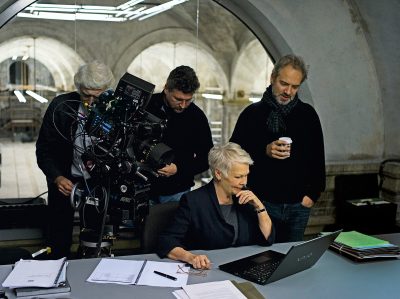
The film, lensed by DOP Roger Deakins on digital ARRI Alexa cameras, features over 1300 visual effects shots with work by Double Negative, MPC, Cinesite, Framestore, Peerless Camera Company, BlueBolt, Lola and Nvizage. Special effects and miniature effects supervisor Chris Corbould also oversaw a team of artists completing various miniature elements.
We take a look at just some of the major sequences, including the opening train sequence and Bond’s shooting, the MI6 explosion, the Komodo dragon casino attack, the London Underground encounter, the final Scottish highlands scenes and the main titles.
Click here to listen to Mike Seymour’s podcast interview with Skyfall visual effects supervisor Steve Begg.
MAY CONTAIN SPOILERS
Bond on a train
Skyfall’s pre-title sequence is a 15-minute chase on a wide variety of transport across Turkey. Eventually, Bond (Daniel Craig) grapples with an assailant atop a train before being accidentally shot by fellow agent Eve and falls into a river below. Double Negative, which also handled later scenes of the assassination in Shanghai and views of the villain’s hideout, tackled the Turkey chase.
A breakdown of Cinesite’s Komodo dragon vfx.
Cinesite created an early test for the Komodo dragons before being awarded the scene. “For reference we went up to London Zoo to look at Komodos,” recalls Cinesite visual effects supervisor Jon Neill. “One was hand-reared so it was quite friendly. Another one was a female born in the wild, and so was not tame like the other one. We took lots of close-up hi-res stills of its body and head, eyes, feet. For the animation reference, we set up three HD cameras on the female and we sync’d them to shoot her eating mice.”
The Komodo model was built using Maya, Mudbox and Mari, with an incredibly high resolution displacement map required for the leathery skin. “We actually had the problem initially of our dragon being too detailed,” admits Neill, “so we made a dirt pass to cover his underbelly – it really covered up all the texture and made it a browny and gray. We also sourced real scars on real Komodos and replicated those.”
Animation proved challenging for the Cinesite team. “The interesting thing about Komodos is that they don’t move much,” notes Neill. “When you see them they just sit there for a long time, and wander across, so it was hard to get subtleties in there. But this was not about the Komodos – this was about the scene. You see them in the shadows, a tongue coming out, and crawling out of the shadows. Roger Deakins likes to light things with silhouettes and rim lights, and that really suited us and the sequence. The pit was actually all candle lit and had banks of candles in each corner.”
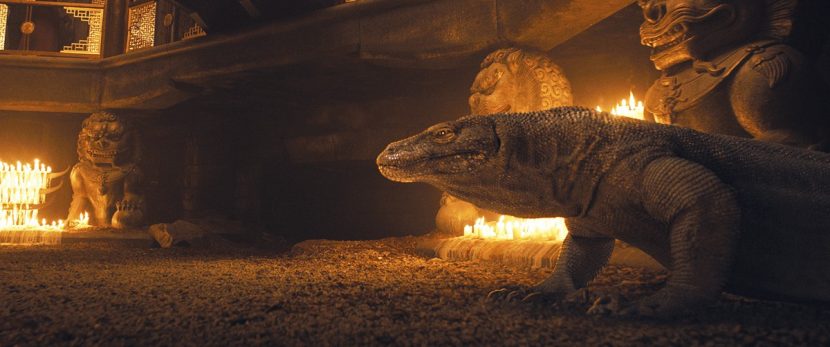
In the sequence, a Komodo slowly moves in on Bond’s attacker before grabbing his ankle and dragging him away. Cinesite had to match dust interaction from the on set gravel and fuller’s earth mix as the dragon takes the ankle. “We also did tests of saliva that Komodo’s use to usually poison their prey and wait for it die,” says Neill. “But we couldn’t have the Komodo biting him and then waiting for days – it wouldn’t be very exciting!”
For Bond’s escape, Daniel Craig jumped onto a green ramp that would later be replaced with a CG Komodo. “The problem,” says Neill, “was that it was a static ramp and he’s supposed to be jumping along a running Komodo. So we had to warp Bond’s leg to make it look like it was traveling with the Komodo as it moved.”
Into the Underground
The mastermind behind much of the film’s mayhem is revealed to be Raoul Silva (Javier Bardem), who is brought to London but ultimately escapes into the London Underground. Here, Cinesite carried out wire and rig removal work for an escalator stunt, set extensions for a chase through the Tube tunnels, and augmentations for a explosion set off by Silva and an actual train crashing through a tunnel roof.
A raw camera view of the train crashing through the catacombs.
For the explosion shot – where Silva is confronted by Bond within the catacombs of the Underground – production filmed at Pinewood Studios. “Daniel Craig was actually in the same set when the bomb went off – it was only 20 feet behind him,” says Jon Neill. “Roger Deakins had ten Alexas in there filming, two in the ceiling, one in the floor and the rest positioned behind arches. There was also a hand-held camera right in front of Daniel, so what we had to do was remove any camera views and replace Bond’s legs and all the ground below Roger Deakins and the crew.”
Cinesite also dealt with light interaction and the set’s wet floor, plus wires seen pulling off part of the roof to reveal a hole. The explosion is followed by a Tube train crashing straight through the gap, realized as a full-scale effect rigged by Chris Corbould’s team. The train was hung from inverted rails, ripping through the false ceiling. Ultimately, Cinesite removed the connected brackets, aided in dust interaction and placed Craig into the scenes.
The final explosion and crash.
“There was a big discussion about green or gray screens being used for the shot,” says Neill. “Roger Deakins is not keen about the contamination in the lighting, so we decided to just do roto. Luckily, Bond has short hair and it’s a fast sequence. Also if we put any kind of screen in there we would have been in the way of the ten cameras and have blocked one of the shots. We needed the freedom offered by roto. We didn’t have to light a greenscreen and we had Bond in the right lighting.”
Cinesite also added in a driver to the train – shot separately against green which was much easier to re-create to match the cab lighting – and also tracked in an ‘Out of Service’ message on the train to denote the lack of passengers. “We also filmed some elements of throwing bricks at camera against greenscreen, just in case we needed to cover any specific bricks and we used it on some of the shots,” adds Neill. “But the practical stunt was fantastic. There was a 30 minute countdown – it was like being at NASA!”
Showdown at Skyfall
Bond and M (Judi Dench) head to Skyfall, his remote childhood home in Scotland, setting a trap for Silva to follow. Here, MPC helped create Scottish Highland environments, the crash landing of a helicopter, a foot chase over a frozen lake and many other enhancements.
Using stills acquired in Scotland, MPC built a high resolution 360 digital matte painted cyclo with simple geo. “We had nearly 300 shots to put the environment in,” explains MPC visual effects supervisor Arundi Asregadoo. “We needed to have the flexibility for Sam to look at the shots and design them. When we first did the layout we had these big, massive mountains but he felt it was too cumbersome and took too much away from the Skyfall lodge, so we had to make it more open. So it’s kind of got the feelings of the mountains of Scotland but re-designed the way Sam had envisaged it.”
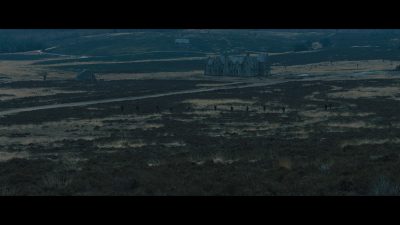
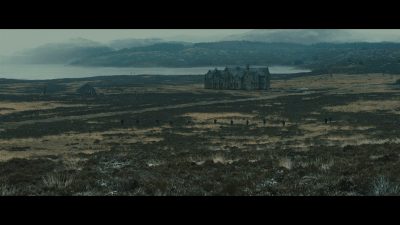
Silva arrives via helicopter, which later crashes into the Skyfall lodge. A miniature helicopter crash was augmented by MPC to include CG rotorblades and extra destruction. “We used our in-house destruction tool Kali to simulate the bricks,” says Asregadoo. “We had to re-build the helicopter too and re-project it – the rig was quire rigid so it felt it was just going in a straight line. We had to re-animate it to give it more pitch, more dive and acceleration into the building.”
The final crash featured a mix practical and miniature elements, a CG house and roof, fire elements, and digital downdraft from MPC. “For the downdraft we created a huge simulation of stuff kicking up to replicate what we saw happen to the grass in the plates,” notes Asregadoo. “Once we had a very long sim, we could render it through each of the cameras.”
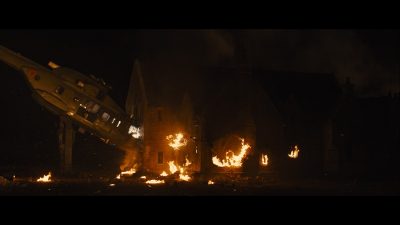
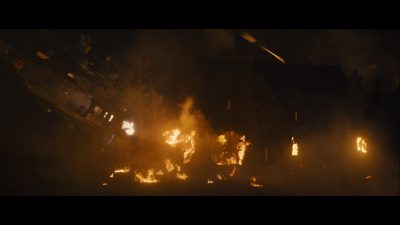
The Skyfall showdown also showcases the earlier destruction of Bond’s Aston Martin DB5, which takes on bullet hits before being blown up. “We built a CG model of the Aston Martin as part of the damage build-up,” says Asregadoo. “In one shot there was a 120 degree camera track around the DB5, and then we broke that down by building a greenscreen version of the bonnet shot as motion control. At the direction of Chris Corbould we did 23 passes of squib hits going off on the bonnet, then we shot tons of glass of breaking and cracking for the bullets hitting the windscreen.”
“Then once we had the elements,” adds Asregadoo, “we used the DB5 and projected that damage onto it, adding some more elements. Actually, originally when we built the DB5 damage we had holes all inside of it, then someone realized the DB5 is bullet-proof! So we had to fill in all the holes.” A third scale DB5 was crafted by the miniature effects unit with the aid of some rapid prototyping by 3D printing company Voxeljet and outfitting from Propshop Modelmakers. MPC combined a clean plate of the DB5 with projected damage and augmented the explosion of the scale car and a stand-in vehicle.
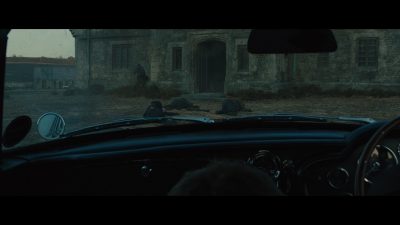
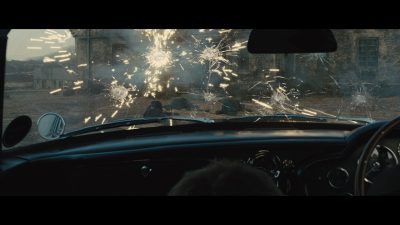
Bond fights one of Silva’s followers along a frozen lake and they fall through the ice. For the running chase, MPC extended a lake set filmed at Longross Studios, replacing a light matrix set up by Roger Deakins to represent the now burning lodge. Breath, mist and smoke elements, along with DMP-based environments were also added.
Asregadoo says the underwater views of the lake were particularly challenging. “It was tricky because when you’re underwater, red channel light doesn’t travel that far visually in your eyes. It’s very much more of a cyan feel underwater even though you’ve got a burning element in there. Roger wanted to make sure it was very red reflected underwater. The underwater shots were filmed on the U stage at Pinewood – we had a two and a half D approach with 2D for the ice, shot elements for the bubbles. The only bit we used CG for was the flare and bubbles when that goes off and reveals the hole in the last shot before he comes out.”
BONUS INTERVIEW: Framestore’s main titles
Framestore visual effects supervisor William Bartlett and 3D artist Martin Aufinger talk about the main titles work.
fxg: These incredible titles certainly feel darker and more graphic in many ways – what were some of the overriding principles Framestore followed in their execution?
Framestore: There were a couple of overall themes that we fed into all our concept work. The main one was the sense that the whole thing was in some sense underwater. Part of it is literally underwater but we tried to keep some of the visual cues throughout the whole sequence particularly the swirling volumes and the floating elements. We also designed some of the environments with the underwater theme in mind like the sandy floor in the vaulted scene with the moving shadows. As well as being underwater Bond is close to death (or is he?) and so there are plenty of skulls, blood, guns, knives, graves, shadows and fire. Once you add in a few girls to that lot it is hard to see how we could have gone wrong….
fxg: Can you talk about how you worked with Daniel Kleinman on the titles – what kind of artwork and concepts did you receive? How far do you take motion tests etc before finaling?
Framestore: As usual we started bouncing a few ideas around quite early on. We begin with more ideas than we need and gradually whittle it down to the best ones and the ones that sit together. Danny gives us some broad concepts and draws up a lot of frame ideas that we then start doing moving image tests and feed back any other ideas that we think of around the themes he has set out.
Once we have narrowed it down a bit we worked with our partners at ‘The Third Floor’ and our visual development department to work up a previz and a few concept frames and at the same time we worked up some technical tests so we could approach the style and look from the other direction so to speak. All these tests and ideas get bounced around and suggest new things. Danny is very open to us suggesting new ideas and we work very much in collaboration with him to find ways to create new and interesting designs. We also got a lot of reference form the main production of the film. More than ever before we have visually weaved in parts of the film into the titles.
The design of the Chinese dragons, the design of the underground vaulted scene, and of course Skyfall itself were all based on locations from the film. Although we had a block out of almost all the sequence we more or less start again after the filming has taken place and you start to block out a rough structure. Even at this point the music was not edited so we knew that whatever we did we need to be pretty flexible as we will have to look again at timings when the song is finalised. From all our technical tests we probably know at this point how we will do about half of the sequence and the methodology for the other half evolves over the course of the job.
fxg: How did you achieve the opening vortex/liquidy world? What elements did you have and what tools and techniques were used for the ink and liquidy feel?
Framestore: There were two separate techniques for the opening sequence. Half of the shots were based on the live-action shoot in an underwater tank combined with elements, Nuke particles and a lot of creative grading to set the right mood.
The seabed shots feature a full cg environment. We originally shot a model of the seabed but for various reason, mainly lighting and flexibility with the camera move it was replaced by a full cg version. It is made out of a huge skull covered with silt which we created using quite dense volumes. Lighting and rendering as well as all the dynamic elements such as the vortex were created with Houdini.
fxg: How were the flaming skulls realised during the titles?
Framestore: The flaming targets were all shot as individual elements and then combined with a particle generator in Nuke. Originally they were separate from the Dragons but the two sections worked so well together that we combined them into a single scene. We did several tests for the targets before we shot them. We tested various things including the thickness of paper and whether to douse them in lighter fluid to get the perfect burn; not the easiest test to carry out on the streets of Soho!
fxg: There’s a neat combination of seaweed, blood vessels and weeds for one part, and then later there are the Chinese dragons – can you talk about some of the modeling and animation challenges here?
Framestore: The scene with the blood vessels was again created in Houdini. We had really good experience with Houdini and its renderer Mantra on this project. In particular all the volumetric rendering using PBR (physically based rendering) worked like a treat. The blood vessels were created using L-systems as a source for our fluid simulation. They were animated procedurally by modifying temperature and velocity in order to push the fluids along the strands.
For the section with the graveyard we modeled a couple of gnarly trees and attached tree weed to them. We actually used fur for this, animated by a wire simulation that had to match the slow, underwater feel of the sequence. It was again all covered in volumes to get natural depth hazing and a nice atmospheric feel.
The Chinese dragons were based on the the Dragon shaped entrance to the casino that appears in the film. We used a scan of the entrance as a guide for modelling but modified it to match the feel of the title sequence.
The setup for the dragon was quite complex. It was essential to add many dynamic elements such as the beard, fins, additional floppy pieces of cloth etc. in order to give it interest and scale. The whole build was approached in a procedural way as we were not sure about the size of the Dragons when we set out to build it. Up to the very end we were able to change the length and shape of the Dragons body dynamically. The rig, all the additional body elements as well as the textures adjusted automatically.
The dragons could be positioned by laying out simple paths. Once the basic layout was approved we added detail to the animation by procedurally adding imperfections to the movement of the individual elements as well as keyframing other parts such as the jaw. We then had to run dynamic simulations for all the body elements, the beard, the fins, subtle movement of the eyes and eyelids, …
Apart from modelling and texturing the head, the entire dragon sequence was created in Houdini. In order to achieve the even interior lighting effect of such a long but thin creature we had to add about 50 geometry lights for each Dragon. Mantra handled the challenge very well.
fxg: The look beneath Skyfall seemed much more sytlized and had great shadows – what was your brief here?
Framestore: The final sequence features Skyfall, crumbling gravestones and a very stylized blood rain. The initial brief was quite different to the final result as this part was meant to look like a shadow puppet theater. Quite late in the project we changed it to what it is now as it fits the look and the mood of the rest of the piece much better. However, it was essential to keep it quite graphic and to play with volumetric lighting and shadows.
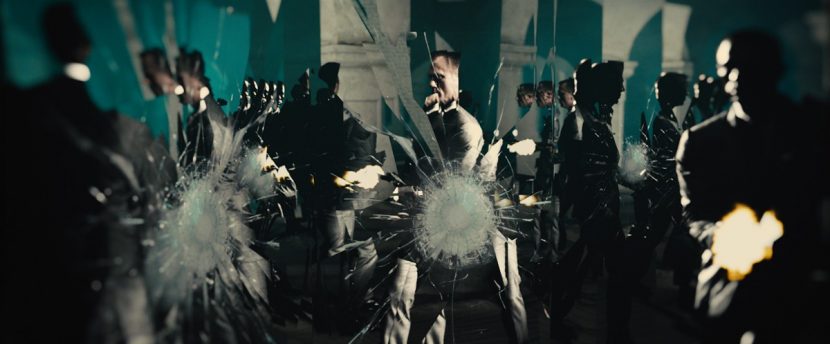
fxg: What techniques did you use for the Rorschach/kaleidoscope effects?
Framestore: The idea for this section that sits over the middle eight in the song was to have a kind of reprieve of what we have seen so far but presented in a new way. Specifically we wanted something that was more graphic and two dimensional after all the sophisticated camera moves and volumes that we had already seen. We also wanted something that was a bit more classic bond but of course still needed to have much in common with the feel of the rest of the sequence. We mapped out the timing and the fractal zoom in Nuke and then when we had picked all the girls we fed them to Houdini where we processed a 2D fluid simulation driven off their movement. We had always intended to add a bit of colour to the final thing but in the end it seemed to work so well black and white that we left it.
fxg: How was the breaking mirrors section completed?
Framestore: We filmed five versions of Daniel all at once all on one camera using real mirrors. This was a surprisingly tricky thing to set up as we wanted him against bluescreen and we wanted reflections from both his left and right side and some along side him and some behind him. We actually prevized the camera, mirror and blue screen set up in Maya to work out the layout and dimensions. Once we had the footage we re-projected it in Nuke and built a scene with multiple versions. We fed the Nuke camera move into Maya to render three separate backgrounds. These were then split in Nuke to match the mirrors. The cracking was all done in Nuke and is just offset layers with a few details added on top.
fxg: Finally, how were the close up zooms to Daniel Craig’s eye achieved?
Framestore: This was in two parts. We shot a camera move into Daniel in the studio but this was never going to be high enough resolution to go right into his eye and we could not hold focus it we went as close as we needed. We also took some high res stills with a macro lens and then blended form one to the other during the shot.
All images and clips © 2012 Danjaq, LLC, United Artists Corporation and Columbia Pictures Industries, Inc. All rights reserved.

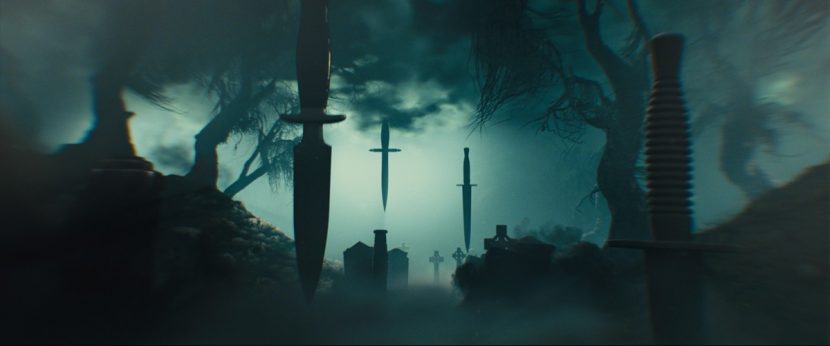
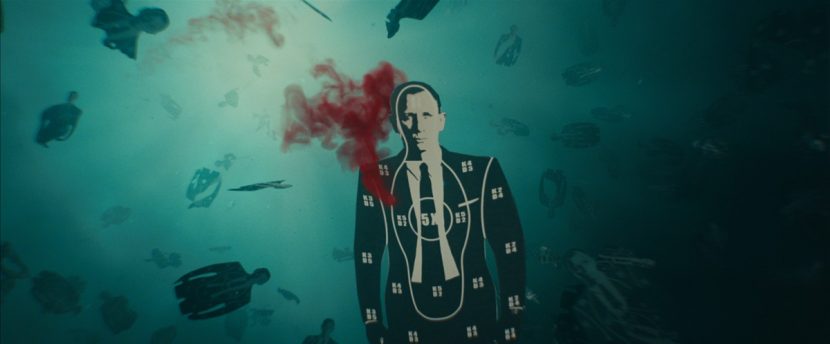
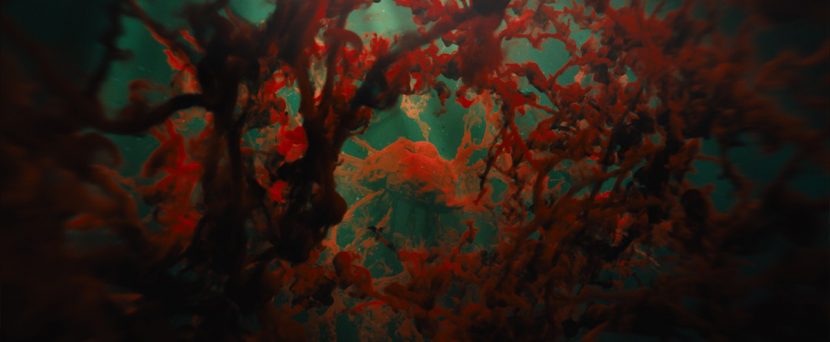
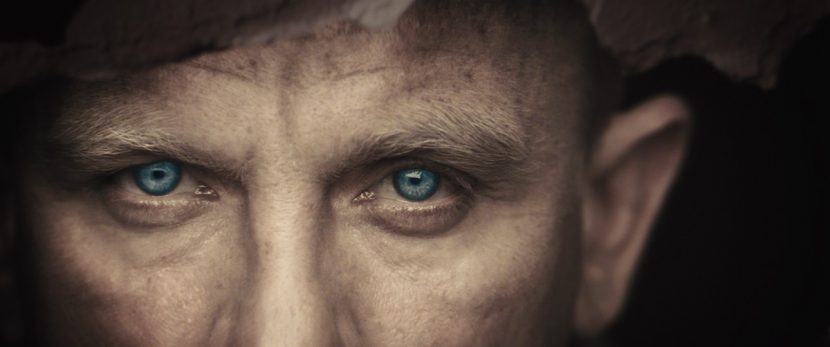
Pingback: Bilinmeyen gerçekler / 25 Film
Pingback: 25 Kickass and Interesting Facts About Trains – KickassFacts.com
Pingback: Pouring Phosphorescent Ink into Water is a Sight Right Out of SKYFALL - Radbot Games
Pingback: POURING PHOSPHORESCENT INK INTO WATER IS A SIGHT RIGHT OUT OF SKYFALL | Bored Nerdist
Pingback: Pouring Phosphorescent Ink into Water is a Sight Right Out of SKYFALL - Big Box of Geek
Pingback: Vén màn hậu trường các bộ phim nổi tiếng để khám phá 10 sự thật mà chỉ “fans cứng” mới biết! – Cuồng phim test